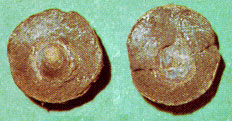
Ancient Life in Kansas Rocks, part 10 of 27
Crania, on the two shells in the upper left, and Lingula, lower right, are both inarticulate brachiopods, and thus lack interlocking hinge mechanisms, having the valves held together only by muscles. Lingula has a shell of calcium phosphate. Modern forms of this genus, which is found in the fossil record esentially unchanged back to ther Ordovician, burrow in soft, muddy, dark-colored sediments and move up and down within their burrows on a long leathery or fleshy stalk-like extension (pedicale). They are found in marine or brackish water in poorly oxegenated estuaries and mud flats. (Ozawkie Limestone, Upper Pennsylvanian)

Crania is a genus also not yet extinct. As shown in the photograph, slightly enlarged, this small calcium carbonate fossil is commonly found with the pedicle valve cemented to another organism, in this case to the shell of the articulate brachiopod Composita. It is also found cemented to other organisms such as crinoids and mollusks, As revealed by the animal to which it was attached, Crania lived in normal marine waters. (Ozawkie Limestone, Upper Pennsylvanian)

Orbiculoidea is an inarticulate brachiopod, its valves held together by muscles only, and has a chitino-phosphatic shell. (Iatan Limestone, Upper Pennsylvanian)
Kansas Geological Survey
Placed online Feb. 1997
URL = "http://www.kgs.ku.edu/Publications/ancient/f10_inart.html"
Send comments and/or suggestions to webadmin@kgs.ku.edu